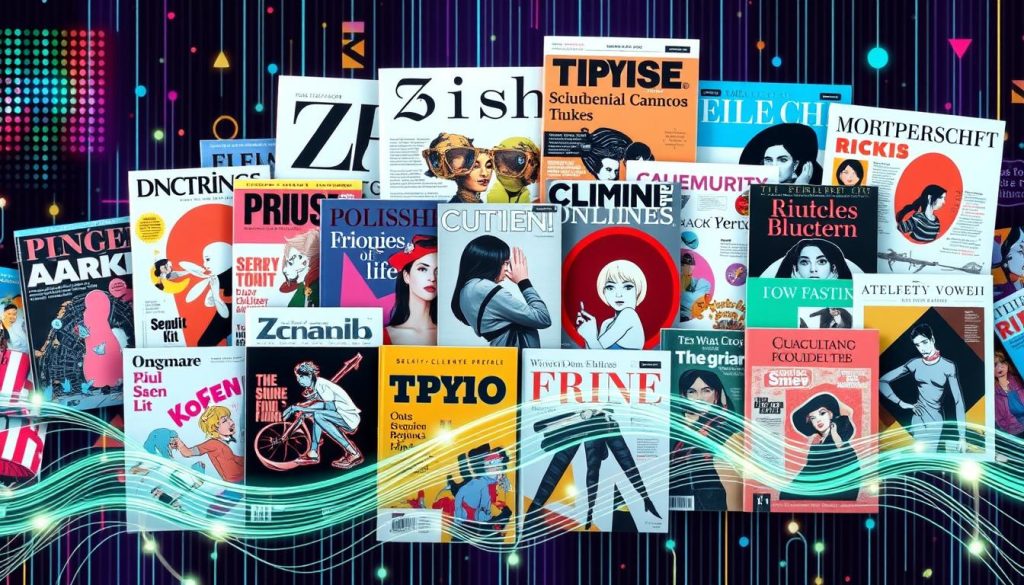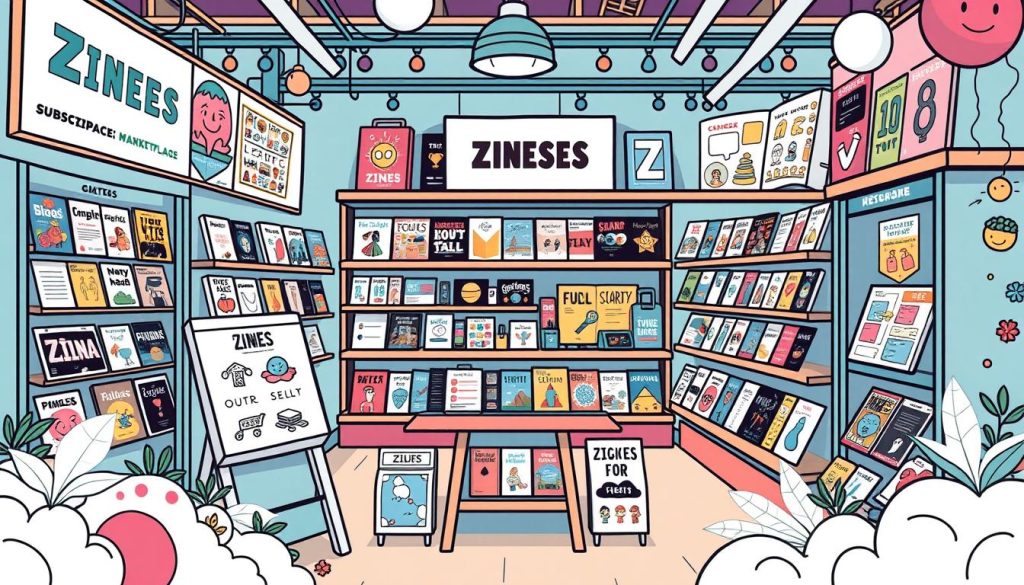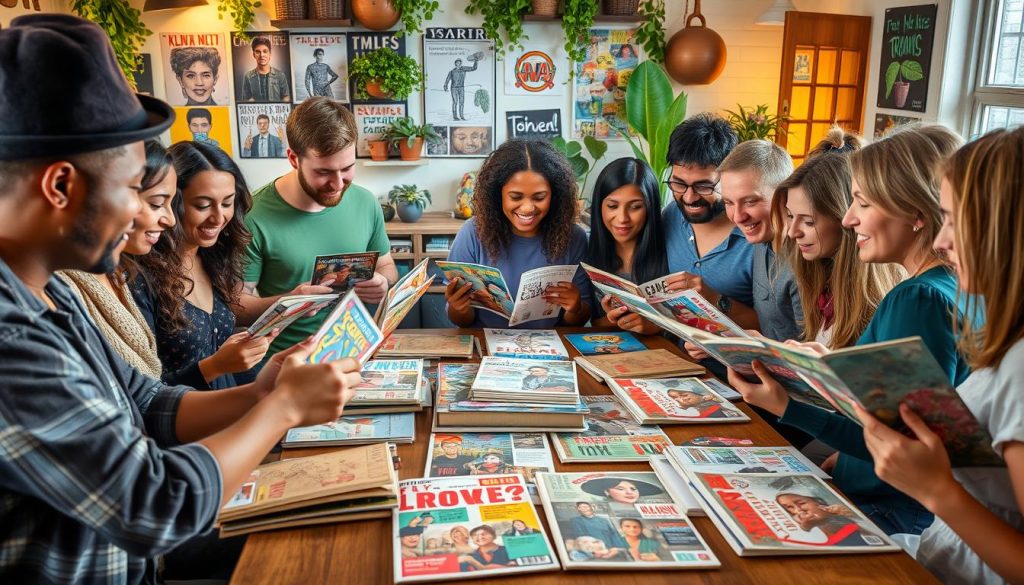Online zines have changed the way we see digital publishing. They offer a new view on independent publishing and give a voice to diverse voices. These online magazines focus on specific groups, bringing unique content and formats that break free from old publishing rules.
We will explore the importance of online zines in today’s digital world. They are key for creativity, learning, and speaking out. Let’s dive into the world of online zines and see how they make a difference.
The Rise of Online Zines in Digital Publishing

The internet has changed how we make and share content, offering a new way that’s different from old print media. The Pew Research Centre found that 82% of people in the UK now get their news online. This shows how digital publishing is becoming more popular.
Platforms like Issuu and Medium have made it easier for independent creators to share their work. This has opened up new opportunities for diverse voices to be heard. The COVID-19 pandemic has made even more creators turn to online formats to share their ideas.
What Sets Online Zines Apart from Traditional Magazines

Online zines are different from traditional magazines in many ways. They offer more flexibility and creativity in content creation. They let independent creators show off their unique styles and voices freely. This is unlike the strict rules in traditional magazines.
Online zines also have faster publishing times. They can quickly respond to new trends or events. This makes them more relevant and timely for their readers.
Online zines use multimedia like videos, audio clips, and interactive features. This gives readers a richer experience. It’s something traditional magazines can’t match. As media changes, online zines play a big role in showing what independent publishing can do.
Online Zines: A Platform for Emerging Voices

Online zines have become key places for underheard voices to shine. They let independent publishers share unique content with specific groups. This includes topics like environmental activism, mental health, and LGBTQ+ issues, which speak to young people looking for real stories.
Identifying Niche Markets in Online Zines
Finding and focusing on niche markets is key for indie publishers. Online, creators can connect with readers on special topics. Some examples of these markets are:
- Environmental issues and sustainability.
- Mental health advocacy.
- Subcultures in fashion and art.
- LGBTQ+ rights and representation.
This focused strategy builds strong bonds with readers, making them more engaged and loyal.
Case Studies of Successful Online Zines
Some online zines show how to build communities around shared interests. For example:
- The Gentlewoman: This zine mixes fashion with feminist views, attracting a loyal readership.
- Aint-Bad: It focuses on modern photography, linking artists with collectors and building community bridges.
These examples show how online zines match their content with what their audience cares about. This approach leads to success in independent publishing by keeping readers involved.
The Evolution of Content Creation in Online Zines

Online zines have changed a lot thanks to new technology. Now, creators can use platforms like WordPress, Substack, and Squarespace to share their work. This change lets more people share their ideas and stories.
Now, readers can also create content for zines. Social media has made this possible. Zine makers are now working with their readers, making zines more diverse and engaging.
Good online strategies are key to getting more people to see and interact with zines. Zine creators use social media to promote their work. They use special promotions and ways to connect with readers, making their content more popular.
Key Elements of a Successful Online Zine

A successful online zine needs great design and an eye-catching look. It must grab the attention of potential readers. Use zine aesthetics that make it stand out. Typography, colour schemes, and layout are key to making it engaging.
Tools like Canva help with design, making it easy to create attractive zine content. Arranging graphics and images well can make a zine look great and match its theme.
Design and Aesthetic Considerations
Choose colours and fonts that fit the zine’s topic and audience. For example:
- Bold colours work well for a lifestyle zine for young readers.
- Subdued tones add sophistication to a literary zine.
- Custom illustrations add personality to the zine.
Paying attention to details shows you’re professional and trustworthy. This builds trust with readers. Being consistent across all pages also strengthens your brand.
Content Strategies that Engage Readers
Good content is the heart of an online zine. Use interactive features like polls and comments to get readers involved. Regular updates with interesting topics keep readers coming back for more.
Storytelling, through personal stories or deep interviews, helps connect with readers. This builds loyalty and creates a community around shared interests.
Online Zines: Monetisation Strategies

Monetising zines can be tough, but there are many ways to make money. One good way is through subscription models. Creators can offer special content for a fee, getting a steady income from loyal readers.
Using Patreon can also help with finances. Patrons give regular support for special perks, building a community and loyalty. Advertisements are another way to earn. By choosing ads that match the audience’s interests, zines can keep trust while making money. Plus, affiliate marketing lets creators earn by promoting products their readers like.
Merchandise sales are another way to make money. Selling branded items boosts the zine and connects with readers. Hosting workshops and events can also bring in income and engage the community. By trying different ways to make money, zine publishers can stay strong in the online world.
The Role of Social Media in Promoting Online Zines

Social media is key for creators to promote online zines well. It lets them talk directly with readers and build a community. By using smart social media marketing, zine authors can reach more people and get more engagement.
Using Instagram and Twitter for Engagement
Instagram and Twitter are big in helping zines get noticed online. Instagram focuses on pictures, letting zine creators show off their best work. This makes a strong visual story that shows what the zine is about. It offers:
- High-quality images and stories to grab people’s attention.
- Targeted hashtags to reach more people beyond just followers.
- Working with influencers to create buzz and interest.
Twitter is great for starting conversations and sharing news fast. By posting interesting tweets and threads, zine creators can get people talking. This platform is good because it lets them:
- Talk to their audience right away, answering questions or comments fast.
- Use trending hashtags to join wider discussions.
- Share links to new content, bringing more people to the zine.
How to Launch Your Own Online Zine Business

Starting an online zine business needs careful planning and action. First, define what your zine is about and who it’s for. Knowing what your readers like helps make sure your content hits the mark.
Then, pick a good platform for your zine. You can choose from WordPress, Medium, or special zine hosting sites. Look at each one’s ease of use and design options to match your goals.
Make a content calendar to keep your publishing regular. This plan should show what content you’ll have and how often you’ll post. Regular updates keep readers coming back and make your zine more visible.
Networking is key when starting a zine business. Connect with other zine makers to share tips, work together on projects, and learn from their journeys.
Use social media to market your zine to your audience. Post interesting content, talk to your readers, and build a community around your zine. This helps build loyalty among your readers.
Legal Considerations for Online Zine Publishers

Online zine publishers must deal with legal issues to protect their work. It’s key to understand copyright for online zines to avoid problems. Make sure to get rights for all images and text to follow copyright laws. Use images from trusted sources or public domain content.
Also, know the publishing rules about content. You need to watch out for defamation and what’s acceptable. Having clear terms of service and privacy policies helps protect everyone involved.
Being proactive with these legal steps builds a strong base for your online zine. It makes your audience trust and believe in you.
Popular Themes and Topics in Online Zines

Online zines cover a wide range of exciting themes that connect with today’s readers. They often focus on cultural and artistic trends. These topics include identity, politics, and subculture movements. Zines offer unique views, helping readers feel closer to social issues.
Exploring Cultural and Artistic Trends
Cultural and artistic trends are key in online zines. They highlight artistic expressions with features like:
- Interviews with emerging artists
- Exhibition reviews and discussions
- Insights into the impact of art on society
By focusing on these themes, zines start important conversations. They show how art shapes our culture today.
Impact of Current Events on Online Zine Content
Zines quickly respond to current events, making them more relevant. They cover social, political, and environmental issues. This includes spotlighting key movements, such as:
- Black Lives Matter
- Climate change activism
- Grassroots community initiatives
This quick response helps amplify important voices. It also encourages readers to get more involved with these issues.
Building a Community Around Your Online Zine

Creating a strong community in zines is key to having a dedicated readership. By using good strategies to engage readers, zine creators can make a place where everyone feels they belong. This leads to more people getting involved and sharing their stories.
Having a community that cares about your zine helps it grow. It also makes the content richer for everyone.
Encouraging Reader Engagement and Feedback
Starting to connect with readers through fun content is a great way to build community. Here are some tips to get readers talking:
- Set up online forums or social media groups for talking about your zine’s topics.
- Ask for feedback through surveys and comments, letting readers share what they think and suggest new ideas.
- Host online events like Q&A sessions or workshops to bring people closer together and give them a space to talk.
These methods make readers feel part of something special. They also make them feel important in the community. Using what readers say in future issues makes sure the content stays interesting and true to what readers want.
The Future of Online Zines in the Publishing Industry
The future of online zines is looking bright as the publishing world changes. There’s a growing need for real and special content. Zines are perfect for this, offering unique content that big media often misses.
This change means creators can really connect with their readers. It builds a community around shared interests. This is a big chance for zines to grow.
Technology will change how zines look and work, adding things like augmented reality and interactive bits. These new features will make reading zines more exciting. They keep the content fresh and show how zines are adapting to what readers want.
As traditional publishing changes, online zines will keep being important for different voices and views. By embracing the future of online zines, publishers can inform and inspire people. They help keep independent thought alive in publishing.
















